Abstract
We have examined the effect on respiration of the steroid hormone progesterone, administered either intravenously or directly into the medulla oblongata in anesthetized and paralyzed male and female cats. The carotid sinus and vagus nerves were cut, and end-tidal PCO2 and temperature were kept constant with servo-controllers. Phrenic nerve activity was used to quantitate central respiratory activity. Repeated doses of progesterone (from 0.1 to 2.0 micrograms/kg, cumulative) caused a sustained (greater than 45 min) facilitation of phrenic nerve activity in female and male cats; however, the response was much more variable in females. Progesterone injected into the region of nucleus tractus solitarii, a respiratory-related area in the medulla oblongata, also caused a prolonged stimulation of respiration. Progesterone administration at high concentration by both routes also caused a substantial hypotension. Identical i.v. doses of other classes of steroid hormones (17 beta-estradiol, testosterone, and cortisol) did not elicit the same respiratory effect. Pretreatment with RU 486, a progesterone-receptor antagonist, blocked the facilitatory effect of progesterone. We conclude that progesterone acts centrally through a steroid receptor-mediated mechanism to facilitate respiration.
Full text
PDF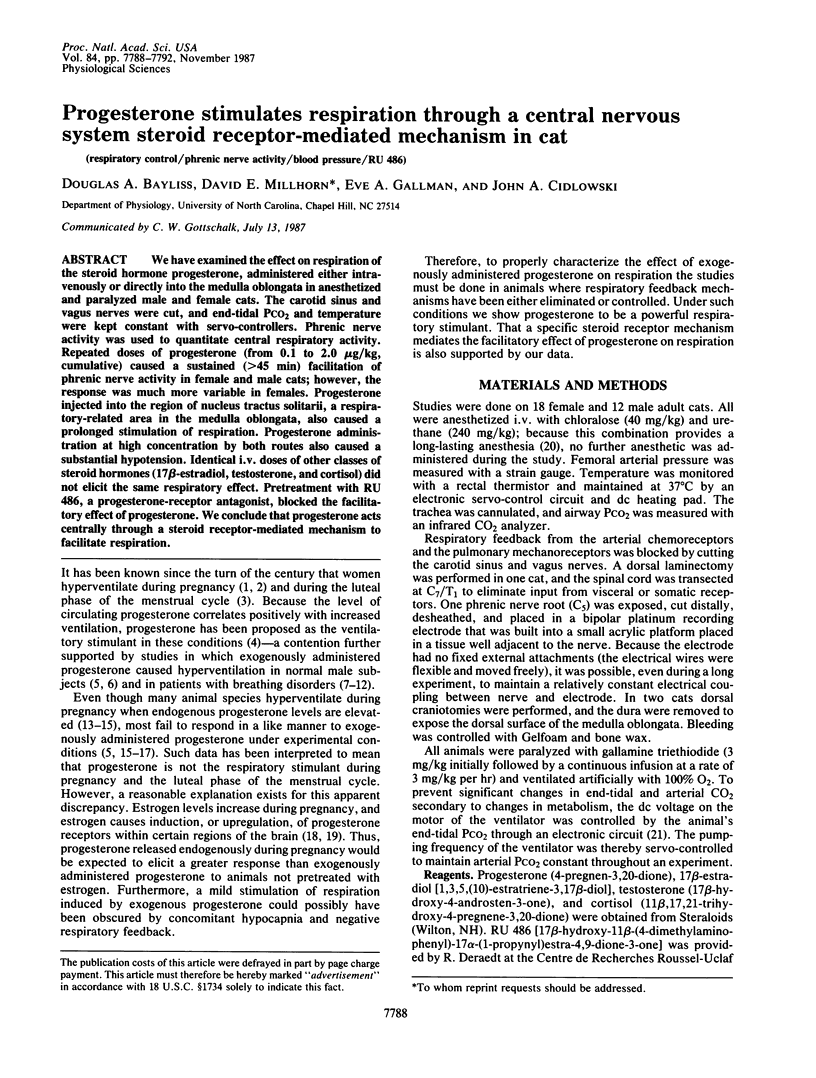
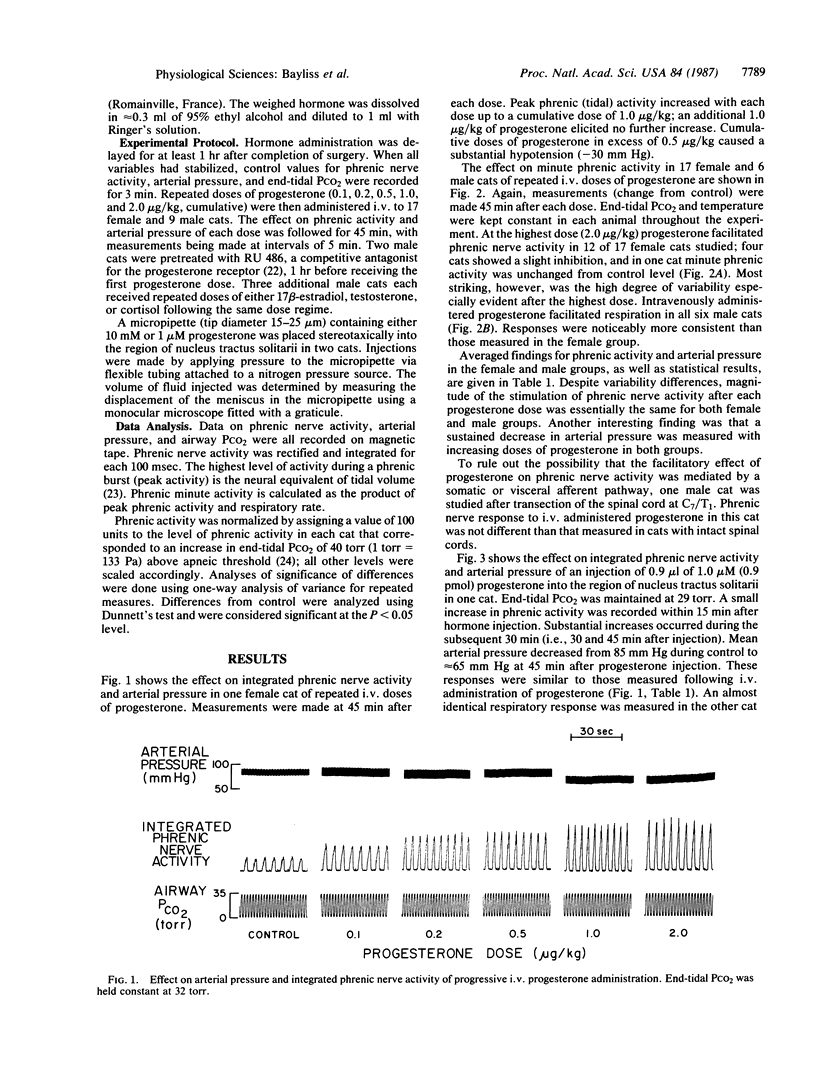
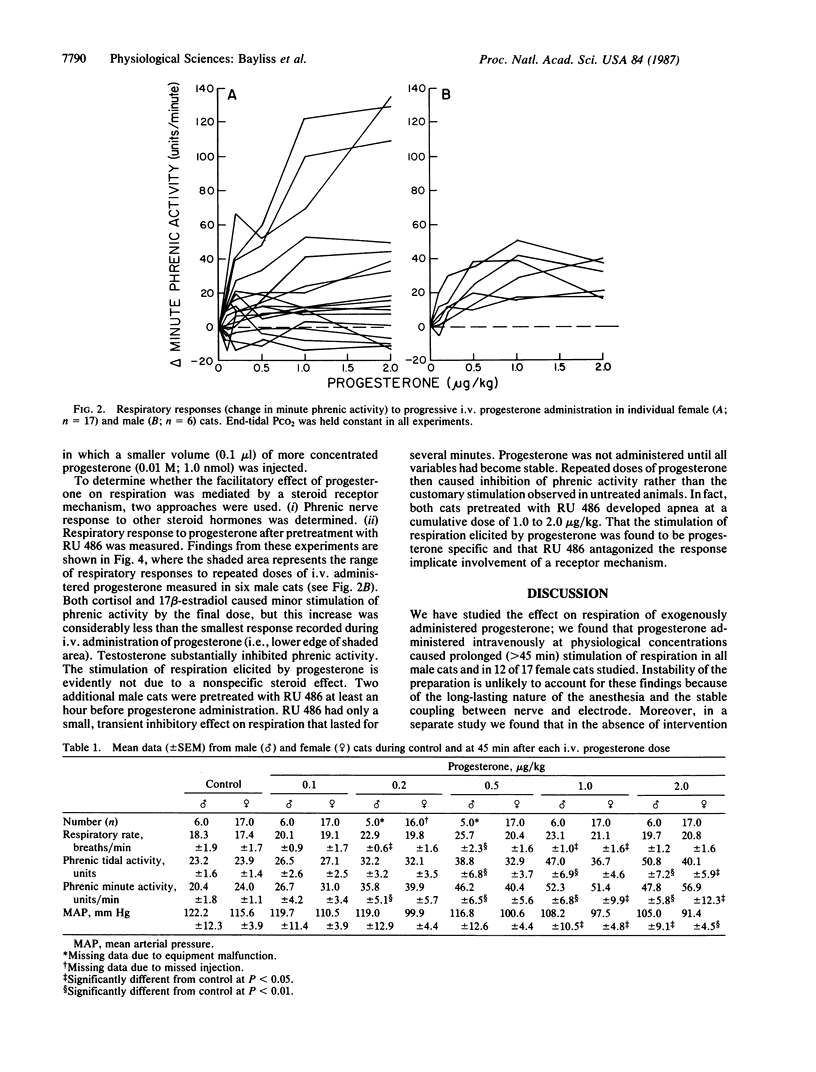
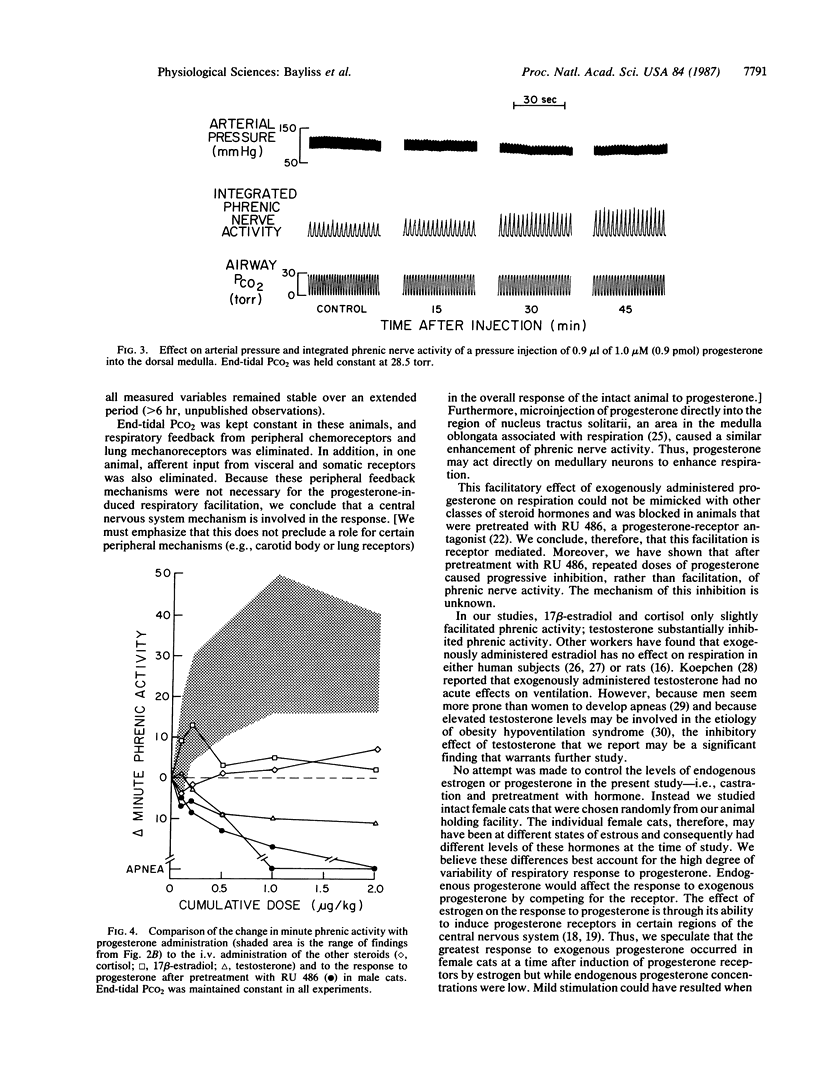
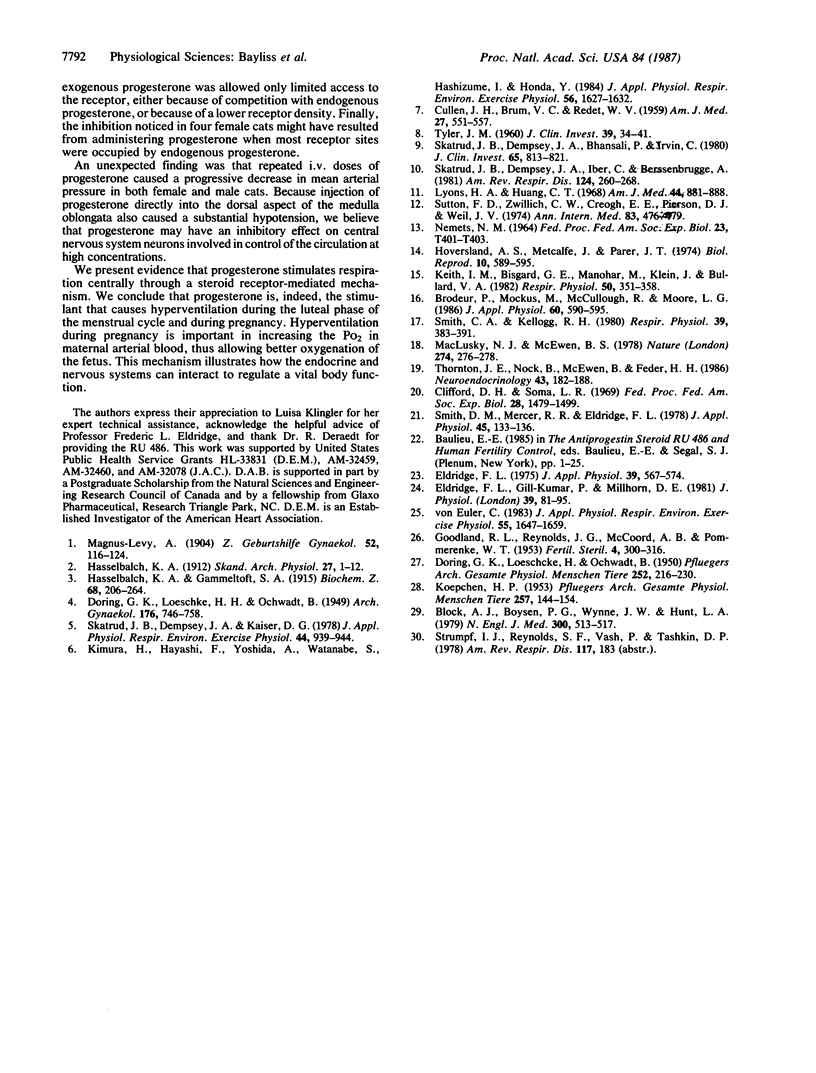
Selected References
These references are in PubMed. This may not be the complete list of references from this article.
- Block A. J., Boysen P. G., Wynne J. W., Hunt L. A. Sleep apnea, hypopnea and oxygen desaturation in normal subjects. A strong male predominance. N Engl J Med. 1979 Mar 8;300(10):513–517. doi: 10.1056/NEJM197903083001001. [DOI] [PubMed] [Google Scholar]
- Brodeur P., Mockus M., McCullough R., Moore L. G. Progesterone receptors and ventilatory stimulation by progestin. J Appl Physiol (1985) 1986 Feb;60(2):590–595. doi: 10.1152/jappl.1986.60.2.590. [DOI] [PubMed] [Google Scholar]
- CULLEN J. H., BRUM V. C., REIDT W. U. The respiratory effects of progesterone in severe pulmonary emphysema. Am J Med. 1959 Oct;27:551–557. doi: 10.1016/0002-9343(59)90040-3. [DOI] [PubMed] [Google Scholar]
- Eldridge F. L., Gill-Kumar P., Millhorn D. E. Input-output relationships of central neural circuits involved in respiration in cats. J Physiol. 1981 Feb;311:81–95. doi: 10.1113/jphysiol.1981.sp013574. [DOI] [PMC free article] [PubMed] [Google Scholar]
- Eldridge F. L. Relationship between respiratory nerve and muscle activity and muscle force output. J Appl Physiol. 1975 Oct;39(4):567–574. doi: 10.1152/jappl.1975.39.4.567. [DOI] [PubMed] [Google Scholar]
- GOODLAND R. L., REYNOLDS J. G., MCCOORD A. B., POMMERENKE W. T. Respiratory and electrolyte effects induced by estrogen and progesterone. Fertil Steril. 1953 Jul-Aug;4(4):300–317. doi: 10.1016/s0015-0282(16)31327-9. [DOI] [PubMed] [Google Scholar]
- Hoversland A. S., Metcalfe J., Parer J. T. Adjustments in maternal blood gases, acid-base balance, and oxygen consumption in the pregnant pygmy goat. Biol Reprod. 1974 Jun;10(5):589–595. doi: 10.1095/biolreprod10.5.589. [DOI] [PubMed] [Google Scholar]
- KOEPCHEN H. P. Uber die Wirkung von Cortison und Testosteron auf die Atmung. Pflugers Arch. 1953;257(2):144–154. doi: 10.1007/BF00412468. [DOI] [PubMed] [Google Scholar]
- Keith I. M., Bisgard G. E., Manohar M., Klein J., Bullard V. A. Respiratory effects of pregnancy and progesterone in Jersey cows. Respir Physiol. 1982 Dec;50(3):351–358. doi: 10.1016/0034-5687(82)90028-7. [DOI] [PubMed] [Google Scholar]
- Kimura H., Hayashi F., Yoshida A., Watanabe S., Hashizume I., Honda Y. Augmentation of CO2 drives by chlormadinone acetate, a synthetic progesterone. J Appl Physiol Respir Environ Exerc Physiol. 1984 Jun;56(6):1627–1632. doi: 10.1152/jappl.1984.56.6.1627. [DOI] [PubMed] [Google Scholar]
- Lyons H. A., Huang C. T. Therapeutic use of progesterone in alveolar hypoventilation associated with obesity. Am J Med. 1968 Jun;44(6):881–888. doi: 10.1016/0002-9343(68)90088-0. [DOI] [PubMed] [Google Scholar]
- MacLusky N. J., McEwen B. S. Oestrogen modulates progestin receptor concentrations in some rat brain regions but not in others. Nature. 1978 Jul 20;274(5668):276–278. doi: 10.1038/274276a0. [DOI] [PubMed] [Google Scholar]
- Skatrud J. B., Dempsey J. A., Bhansali P., Irvin C. Determinants of chronic carbon dioxide retention and its correction in humans. J Clin Invest. 1980 Apr;65(4):813–821. doi: 10.1172/JCI109732. [DOI] [PMC free article] [PubMed] [Google Scholar]
- Skatrud J. B., Dempsey J. A., Iber C., Berssenbrugge A. Correction of CO2 retention during sleep in patients with chronic obstructive pulmonary diseases. Am Rev Respir Dis. 1981 Sep;124(3):260–268. doi: 10.1164/arrd.1981.124.3.260. [DOI] [PubMed] [Google Scholar]
- Smith C. A., Kellogg R. H. Ventilatory response of rabbits and goats to chronic progesterone administration. Respir Physiol. 1980 Mar;39(3):383–391. doi: 10.1016/0034-5687(80)90068-7. [DOI] [PubMed] [Google Scholar]
- Smith D. M., Mercer R. R., Eldridge F. L. Servo control of end-tidal CO2 in paralyzed animals. J Appl Physiol Respir Environ Exerc Physiol. 1978 Jul;45(1):133–136. doi: 10.1152/jappl.1978.45.1.133. [DOI] [PubMed] [Google Scholar]
- Sutton F. D., Jr, Zwillich C. W., Creagh C. E., Pierson D. J., Weil J. V. Progesterone for outpatient treatment of Pickwickian syndrome. Ann Intern Med. 1975 Oct;83(4):476–479. doi: 10.7326/0003-4819-83-4-476. [DOI] [PubMed] [Google Scholar]
- TYLER J. M. The effect of progesterone on the respiration of patients with emphysema and hypercapnia. J Clin Invest. 1960 Jan;39:34–41. doi: 10.1172/JCI104024. [DOI] [PMC free article] [PubMed] [Google Scholar]
- Thornton J. E., Nock B., McEwen B. S., Feder H. H. Estrogen induction of progestin receptors in microdissected hypothalamic and limbic nuclei of female guinea pigs. Neuroendocrinology. 1986;43(2):182–188. doi: 10.1159/000124526. [DOI] [PubMed] [Google Scholar]
- von Euler C. On the central pattern generator for the basic breathing rhythmicity. J Appl Physiol Respir Environ Exerc Physiol. 1983 Dec;55(6):1647–1659. doi: 10.1152/jappl.1983.55.6.1647. [DOI] [PubMed] [Google Scholar]


